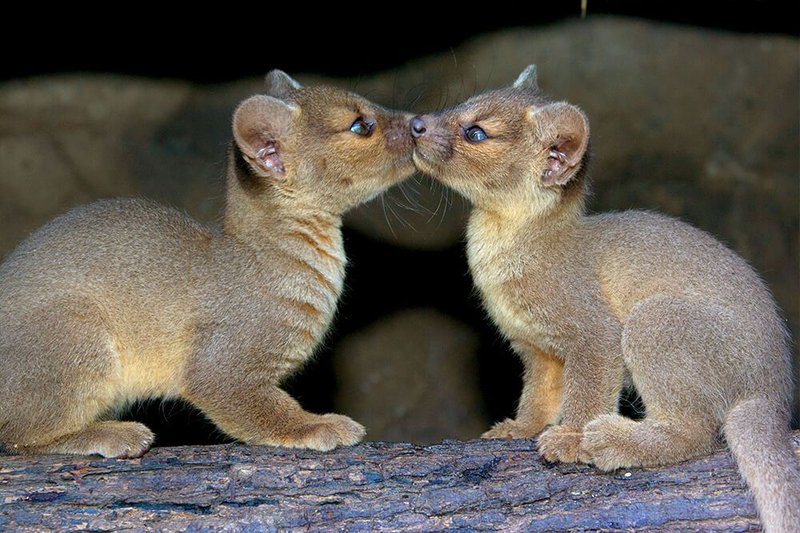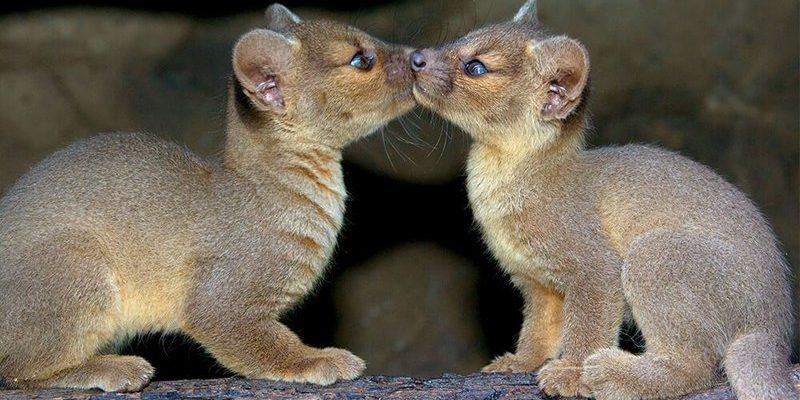
The fossa (Fossa fossana) is the largest carnivore on the island and plays a vital role in its ecosystem. Sadly, it’s often misunderstood, leading to a lot of myths and misconceptions. Just like folks might confuse a dolphin for a fish due to its maritime grace, the fossa is frequently misclassified. So, let’s dive into the world of the fossa, bust some common myths, and learn what really makes this animal tick!
The Fossa is a Cat
One of the biggest misconceptions about the fossa is that it’s a type of cat. While it’s true that the fossa has some feline features, such as sharp retractable claws and a slender body, it actually belongs to a group of mammals called the Eupleridae family, which is closely related to mongoose.
You might be wondering how this misunderstanding started. Well, it’s easy to see why! The fossa has cat-like characteristics, which can lead to this mix-up. Plus, its size is more akin to that of a small dog, making it a bit hard to pin down. Here’s a quick way to remember: think of a fossa as a “cat-mongoose hybrid.” Intriguing, right?
So, if you’re ever chatting with someone who insists that the fossa is just another cat, feel free to set them straight! It’s like thinking your cute little pug is a wolf just because it has a similar nose.
The Fossa Lives Only in Madagascar
Another myth is that the fossa only exists in Madagascar, which is true—but there’s more to the story! This unique animal is endemic to Madagascar, meaning it’s found nowhere else on Earth. It’s considered a “Madagascan icon.” However, the fossa’s very existence is threatened by habitat loss and human activities.
Imagine living in a beautiful, lush forest that’s slowly shrinking. That’s the reality for the fossa. Human encroachment, agriculture, and deforestation are like erasers slowly wearing away their natural habitat. This doesn’t just affect the fossa; it impacts the entire ecosystem, showcasing how interconnected life on Earth really is.
So, while it’s accurate to say the fossa is exclusive to Madagascar, it’s vital to consider the challenges it faces. It’s not just a tale of isolation; it’s also one of urgency and conservation.
The Fossa is a Loner
You might think of the fossa as a solitary creature, scoping out its surroundings like a stealthy ninja. While it does have solitary tendencies, especially when hunting or resting, fossas can also form social bonds. They are known to come together during the mating season, showing that they’re not as anti-social as one might believe.
Interestingly, female fossas have a unique way of communicating. Instead of just the typical vocalizations you might expect from a wild animal, they can produce a range of sounds that can include growls, howls, and even purr-like noises. It’s like they have their own language!
So, don’t be fooled into thinking that fossas are just wandering solo all the time. They have a social side too, which adds to their charm.
The Fossa Primarily Preys on Rodents
While fossas do enjoy a variety of prey, including rodents, that’s just scratching the surface. Their diet is incredibly diverse, and they are known for their agility and hunting skills. In fact, fossas are notorious for their ability to chase lemurs through the trees, using their sharp claws and muscular build to navigate the forest canopy. Talk about being a skilled predator!
Fossas also eat birds, reptiles, and even insects, making them “opportunistic hunters.” This adaptability is crucial for their survival in the ever-changing environment of Madagascar. Think of it like a culinary adventure; they don’t stick to one menu but explore different flavors that their habitat offers.
By broadening their diet, fossas play an essential role in maintaining the balance of Madagascar’s ecosystem. So, the next time you hear someone say that fossas only eat rodents, feel free to share the truth about their diverse palate!
Fossas are Dangerous to Humans
There’s a common belief that fossas are dangerous creatures ready to pounce on unsuspecting humans. Let me explain why this is a misconception. Fossas are generally shy and elusive. They prefer to keep their distance from humans and tend to avoid confrontation at all costs.
While they are powerful predators, they aren’t out to hunt people. In fact, there are very few documented cases of fossas attacking humans. It’s more like a small dog barking at a stranger rather than a fierce tiger on the prowl. So, if you ever find yourself in Madagascar, you can observe these fascinating animals without worrying about being in danger.
Admittedly, any wild animal deserves respect, but the fossa is far more focused on its role in the ecosystem than on being a threat to us.
The Fossa is Endangered, So We Can’t Help It
It’s true that the fossa is classified as vulnerable, primarily due to habitat loss and hunting. However, saying we can’t help it is not quite accurate. There are many ways we can contribute to the fossa’s survival.
One of the most effective ways is by supporting conservation efforts, whether through donations, spreading awareness, or even adopting sustainable practices in our daily lives. For instance, buying products that are sustainably sourced can help protect their habitats.
You might also consider supporting eco-tourism in Madagascar, which allows locals to earn a living while preserving their unique wildlife. It’s a win-win! Just like cheering on your local sports team, every little bit helps in the fight for fossa conservation.
In conclusion, the fossa is a mesmerizing creature wrapped in myth and misunderstanding. Learning the truth adds to its allure and highlights the urgent need for conservation. So, the next time you hear a wild tale about the fossa, you can confidently share the facts and help others appreciate this remarkable animal.

